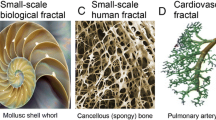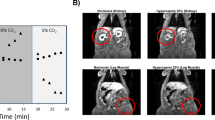Abstract.
Muscle blood flow has been shown to be heterogeneous at the voxel by voxel level in positron emission tomography (PET) studies using oxygen-15 labelled water. However, the limited spatial resolution of the imaging device does not allow direct measurement of true vascular flow heterogeneity. Fractal dimension (D) obtained by fractal analysis describes the relationship between the relative dispersion and the size of the region studied, and has been used for the assessment of perfusion heterogeneity in microvascular units. This study was undertaken to evaluate fractal characteristics of PET perfusion data and to estimate perfusion heterogeneity in microvascular units. Skeletal muscle blood flow was measured in healthy subjects using [15O]water PET and the fractal characteristics of blood flow in resting and exercising skeletal muscle were analysed. The perfusion heterogeneity in microvascular units was estimated using the measured heterogeneity (relative dispersion, RD=SD/mean) and D values. Heterogeneity due to methodological factors was estimated with phantoms and subtracted from the flow data. The number of aggregated voxels was inversely correlated with RD both in phantoms (Pearson r=–0.96–0.97) and in muscle (Pearson r=–0.94) when both parameters were expressed using a logarithmic scale. Fractal dimension was similar between exercising (1.13) and resting (1.14) muscles and significantly lower than the values in the phantoms with different activity levels (1.27–1.29). Measured flow heterogeneity values were 20%±6% (exercise) and 27%±5% (rest, P<0.001), whereas estimated flow heterogeneity values in microvascular units (1 mm3) were 35%±14% (exercise) and 49%±14% (rest, P<0.01). In conclusion, these results show that it is feasible to apply fractal analysis to PET perfusion data. When microvascular flow heterogeneity is estimated using fractals, perfusion appears to be more heterogeneous in microvascular units than when obtained by routine spatial analysis of PET data. Analysis of flow heterogeneity using PET and fractals could provide new insight into physiological conditions and diseases associated with changes in peripheral vascular function.
Similar content being viewed by others
Author information
Authors and Affiliations
Additional information
Received 1 September and in revised form 28 November 2000
Electronic Publication
Rights and permissions
About this article
Cite this article
Kalliokoski, K., Kuusela, T., Nuutila, P. et al. Perfusion heterogeneity in human skeletal muscle: fractal analysis of PET data. Eur J Nucl Med 28, 450–456 (2001). https://doi.org/10.1007/s002590000458
Published:
Issue Date:
DOI: https://doi.org/10.1007/s002590000458




